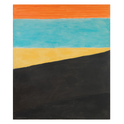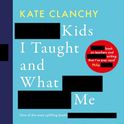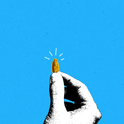In 1988, newly installed as the director of dance at the Théâtre Royal de la Monnaie in Brussels at the age of 32, the choreographer Mark Morris gave his first press conference. What, asked a journalist, was his philosophy of dance? Morris’s predecessor, Maurice Béjart, had been a prodigious philosophiser, providing “30 pages of programme notes for every new dance.” But Morris’s answer ran to far fewer than 30 words: “I make it up and you watch it. End of philosophy.” It was the first of a series of pungent obiter dicta that would infuriate the Belgian press and audiences. But in his memoir, pointedly titled Out Loud, Morris defends his one-liner: “It was looked upon as a snub or a provocation, but… it’s the truth.”
Throughout his career, Morris has always spoken his mind with a dashing lack of filter on everything from the Belgian Queen Fabiola’s coiffure (“the Maggie Thatcher hairdo of death”) to the Nobel laureate Derek Walcott with whom he worked on Paul Simon’s Broadway flop The Capeman (“ham-fisted, bigoted, lecherous, dismissive, patronising and belligerent”).
On his own work, he has been less expansive: “Art shouldn’t need translation. If the artist has to explain things, then he or she may be working in the wrong form.” But at 63, with his dancing (though not his dance-making) days over, Morris is in a more reflective mood: “I now find myself less reluctant to share secrets, happier to let people in on what goes into making up a dance, the workings of my company, my choreographic imagination, and the way these are all aspects of who I am.”
Morris was born in Seattle in 1956, the youngest child of Bill Morris, a high school teacher, and his wife, Maxine, “a woman of completely conventional appearance and manners,” according to his biographer, Joan Acocella, “who was absolutely unswerving in her support of [her] unconventional child.” His formal dance training began when he was nine: his eldest sister, Marianne, was taking pointe classes and, he writes, “I crammed my feet into Tupperware juice glasses so I could imitate her by walking on pointe.” His mother enrolled him with a dance teacher, Verla Flowers, who quickly “saw in me a prodigy, someone worthy of her extra attention and time.”
In his mid-teens, Morris joined the folk-dance collective, Koleda, as one of the youngest members in a group of “sexy college students and kooky adults” where he was “accepted, not primarily as gay, just as someone with the chops for the dances.” The Utopian ethos of Koleda remained a lasting influence: “Every dance I make contains the germs of that experience.” At the same time, he discovered the work of modern American composers—Terry Riley, Harry Partch, Luciano Berio, Steve Reich and Conlon Nancarrow. Taking music, rather than movement, as the starting point for a dance became a lifelong habit: “One reason I make dances is to trick people into hearing music better.”
In 1976, when the 19-year-old Morris arrived in New York, it was “the boom time for both ballet and dance.” He immersed himself in work by the choreographers George Balanchine, Martha Graham, Paul Taylor, Twyla Tharp, Lucinda Childs, and Merce Cunningham (“I found his work as pleasurable as cod-liver oil”). Funding from the National Endowment for the Arts meant that dance was accessible and popular as never before. Morris auditioned for Eliot Feld—“A famously demanding and impatient boss, traits I may have learned from him.” Later he worked with Lar Lubovitch and Hannah Kahn. But “I didn’t just want to be a dancer... In the end, I had to get a group together because, frankly, who else was going to do my dances?”
Morris’s company was made up of friends: “we danced together, travelled together, slept together... No one ever wanted to leave that party.” The group’s first performance was on 28th November 1980 and their reputation grew swiftly. In 1983, the New Yorker critic, Arlene Croce, devoted an entire review to Morris’s work. The timing of Croce’s praise for the freshness of Morris’s dance language was bittersweet: it came as he was leaving the city. Dances such as “Gloria,” “New Love Song Waltzes” and “Dogtown” may have made him “the most talked-about young choreographer in the United States,” but he was surviving on unemployment insurance (“It was quite degrading and very, very helpful”) and his company had no permanent rehearsal space. “New York was all too much for me,” he said.
Morris and his partner, the dancer Erin Matthiessen, settled in a lakeside cottage in Seattle: “Living there seemed like heaven, and it was.” But the idyll was comparatively short-lived. As the Mark Morris Dance Group’s newfound fame brought invitations from as far afield as London and Paris, Morris was constantly making new dances, including the desolate The Vacant Chair, a solo piece for which he wore only underpants, with a brown paper bag over his head, and “O Rangasayee,” to a raga by the Carnatic composer, Tyagaraja.
Morris and Matthiessen’s relationship ended, a rupture marked in the memoir by a brisk account of his subsequent personal life. He quotes Barry Alterman, the former general manager of MMDG, who “said that my perfect boyfriend would be someone I visited in prison. We’d both put our hands up to the Plexiglass that separated us and stare at each other. Longingly. And then I’d leave and get back to work.”
In 1986 there came another of the pivotal moments that have punctuated Morris’s career. A collaboration with the director Peter Sellars on John Adams’s opera Nixon in China led indirectly to Morris’s appointment at la Monnaie in Brussels. That turbulent posting produced some remarkable work, including L’Allegro, Il Penseroso ed Il Moderato, to Handel’s pastoral ode, and Morris’s triumphant farewell to Belgium, The Hard Nut, a darkly comic reworking of Tchaikovsky’s Nutcracker.
*** By the mid-1980s, Aids had begun to take a terrible toll on Morris’s friends: “I presumed that I was HIV positive. There was no particular evidence. It was pure Weltschmerz... and I very melodramatically decided that the next dance would be my last.” There was a sulphurous reaction to his Dido and Aeneas (1989), set to Purcell’s opera, in which Morris took the roles of Dido and her nemesis the Sorceress: “All of Belgium stands speechless before this disaster,” read one headline, while a review referred to Morris’s “dumpy Dido.” He was gratified, on the company’s return to the US in 1991, to find that “we’d been missed.” But the group was “no longer simply a tightly knit group of friends. We’d become an institution.”
[su_pullquote align="right"]“All of Belgium stands speechless before this disaster,” read one headline[/su_pullquote]
After his return to the US, Morris worked with the cellist Yo-Yo Ma, Mikhail Baryshnikov, the composer Lou Harrison, the artist Howard Hodgkin and the conductor Christopher Hogwood “who, despite his great musical mind, was impossible.” He has begun conducting the scores of his dances, observing ruefully that “I didn’t realise I had a bald spot until I started conducting,” and remains open to the idea of future commercial collaboration: “To choreograph one single Disney cartoon for five minutes, I’d fuck a mouse.”Yet an implacable sense of the fragility of life and art haunts this memoir, from the “annus horribilis” when Morris was 14—the family home burned down, their few remaining possessions were lost in a car crash, and soon afterwards his father, uncle and grandfather died—to the gala opening of the Mark Morris Dance Center in Brooklyn on 10th September 2001. The following morning, the company’s first act in their new home was to hand out bottled water to people fleeing the attack on the Twin Towers.
Having stopped dancing, when “I feared that, next to my younger dancers, I might be beginning to look like the creepy uncle,” he found that the times were changing, and with them, his relationship with his company. Remarks such as, “Exit now and don’t forget to take your ass with you,” which had been part of rehearsal-room repartee when MMDG began, offended dancers young enough to be Morris’s grandchildren. “I know I can be a bully, but I was honestly surprised to hear how much it upset them,” Morris writes, describing the painful process of self-examination and adjustment that followed.
He attributes his malaise in part to the political climate after the 2016 presidential election: the sense that “the basic tenets of our art and our lives were under attack [by] an anti-intellectualism that’s been setting in for some time.” Work, as always, proved the antidote, and in his final chapter, Morris explores intimations of immortality—for his dance, if not himself. The preservation of a choreographer’s work is a singular problem: as Acocella observes, “Dance... has no score, no text. Therefore it dies continually. If a dance ceases to be performed, it vanishes... If a dance continues to be performed, it changes with each performance.”
As well as launching a campaign to preserve the dances he has already made, Morris was inspired by Margaret Atwood’s contribution to Future Library, a project to commission 100 pieces of fiction to be published in 2114. His plan is “to keep on making up dances: one a year that no one will see until I’m dead.”
His memoir, too, is part of his legacy: his co-author, the British-born author and musician Wesley Stace, conveys Morris’s profane elegance with exemplary clarity, revealing his paradoxical nature: his deep seriousness and biting irreverence; his devotion to his company and his essential solitariness; his remarkable range of cultural reference and his insatiable curiosity about the world. Most striking, for anyone interested not just in dance, but in creativity, is Morris’s dissection of his own process. As he puts it (with characteristic hubris), “I’m not interested in self-expression but in expressiveness. Geoffrey Hill, the great English poet, said that this ‘put perfectly what [he’d] been trying to say gropingly and inadequately for years.’”
This particular act of expressiveness is a memorably unvarnished self-portrait of the artist—not just a great dance memoir, but a passionate manifesto for the arts as a universal birthright: the guardian, reflection and critic of a civilised society. “I do endings well in my dances,” Morris concludes. He does a good ending here, too: “Time to get back to work.”












